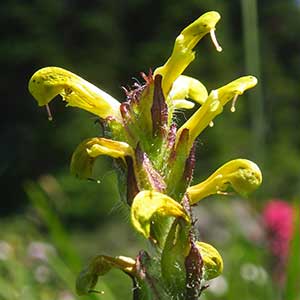Pedicularis rainierensis
Pedicularis contorta
Mt. Rainier lousewort
coil-beak lousewort, coiled lousewort, coiled pedicularis, curve-beak lousewort, curved-beak lousewort, white coiled-beak lousewort
basal 2–5, blade lanceolate, 40–80 x 3–20 mm, 2-pinnatifid, margins of adjacent lobes nonoverlapping or slightly overlapping distally, serrate to 2-serrate, surfaces glabrous;
cauline 2–6, blade lanceolate, 15–70 x 5–20 mm, 1- or 2-pinnatifid, margins of adjacent lobes nonoverlapping or slightly overlapping distally, serrate, surfaces glabrous.
basal 3–10, blade lanceolate, 30–100 x 5–30 mm, 1- or 2-pinnatifid, margins of adjacent lobes nonoverlapping, entire or serrate, surfaces glabrous;
cauline 2–10, blade elliptic or triangular to lanceolate, 5–70 x 10–25 mm, 1-pinnatifid, margins of adjacent lobes nonoverlapping, entire or serrate, surfaces glabrous.
simple, 1–4, exceeding basal leaves, each 10–50-flowered;
bracts lanceolate or subulate to trullate, 10–15 x 1–2 mm, undivided or pinnatifid, proximal margins entire, distal serrate, surfaces glabrous or tomentose.
simple, 1–6, exceeding basal leaves, each 12–40-flowered;
bracts trullate to obtrullate, 5–18 x 2–15 mm, pinnatifid, margins entire, surfaces glabrous.
1–3.5 mm.
1.5–5.5 mm.
calyx 7.5–11 mm, hispid to tomentose, lobes 5, linear to narrowly triangular, 4–5 mm, apex entire, glabrous or ciliate;
corolla 16–19 mm, tube light or dark yellow, 8–10 mm;
galea light or dark yellow, 8–9 mm, beakless, margins entire medially and distally, apex arching beyond abaxial lip;
abaxial lip light or dark yellow, 4–5 mm.
calyx 5–9 mm, glabrous, lobes 5, triangular, 1–3 mm, apex entire, glabrous;
corolla 7–13 mm, tube white or cream to yellowish or pink to pinkish purple, 4–7 mm;
galea white or cream to yellowish with purple spots at base, or pink to pinkish purple, 2–5.5 mm, beaked, beak coiled, 5–9 mm, base curving, margins entire medially and distally, apex surrounded by abaxial lip, axis of coil nearly vertical;
abaxial lip surrounding beak, white or cream to yellowish, or pink to pinkish purple, 5–8 mm.
Pedicularis rainierensis
Pedicularis contorta
Pedicularis rainierensis is known from Mt. Rainier and the Crystal Mountain area. The species is easily confused with P. bracteosa var. latifolia, which often occurs in the same meadows. While the sizes and shapes of their flowers are nearly indistinguishable, P. rainierensis is a much smaller plant with leaves only about three fourths the size, proximal leaf lobes less than one fifth the size, inflorescences about one half the length, and the number of flowers greatly reduced in comparison to those of P. bracteosa var. latifolia.
(Discussion copyrighted by Flora of North America; reprinted with permission.)
Varieties 3 (3 in the flora).
The coiled beak that extends directly downward from the top of the galea is distinctive in Pedicularis contorta. Seen from the side, the large, upward-expanded, lateral lobes of the abaxial lip surround the beak, concealing it from view. The flowers of P. contorta are very similar to those of P. racemosa; however, the leaves of P. racemosa are undivided, the beak curves down and to one side, and the inflorescence often branches, forming a panicle of short racemes with long internodes between flowers.
Flower and calyx color and width of the subtending floral bracts delimit three varieties in Pedicularis contorta; corolla color is difficult to discern in herbarium specimens. The following key is adapted from R. N. Reese (1984).
(Discussion copyrighted by Flora of North America; reprinted with permission.)
1. Corolla tubes, galeas, and abaxial lips white or cream to yellowish, galeas with purple spots at base; calyces pale green. | var. contorta |
1. Corolla tubes, galeas, and abaxial lips pink to pinkish purple; calyces green or reddish with purple spots. | → 2 |
2. Calyces green; bracts 5–8 mm wide, proximal margins ciliate. | var. ctenophora |
2. Calyces reddish with purple spots; bracts 2–4 mm wide, proximal margins glabrous. | var. rubicunda |
- Local floras:
BC,
CA,
OR,
WA
- Local Web sites:
CalFlora,
CalPhotos,
Flora NW,
PNW Herbaria,
Turner Photog.
WildflowerSearch
iNaturalist (observations)
USDA Plants Database
- LBJ Wildflower Center
- SEINet
- Plants of the World Online
- Encyclopedia of Life
- Wikipedia
- Google Image Search


